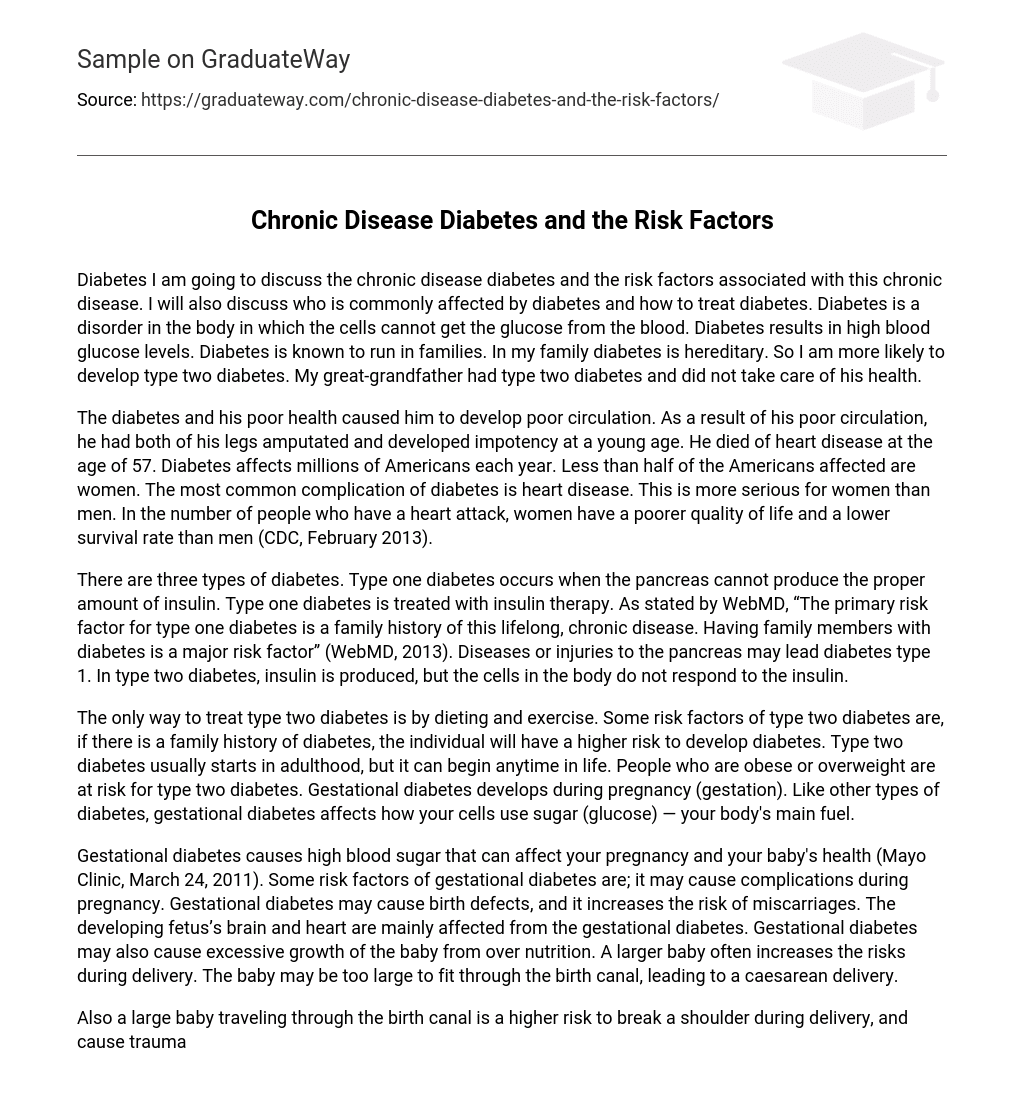Diabetes I am going to discuss the chronic disease diabetes and the risk factors associated with this chronic disease. I will also discuss who is commonly affected by diabetes and how to treat diabetes. Diabetes is a disorder in the body in which the cells cannot get the glucose from the blood. Diabetes results in high blood glucose levels. Diabetes is known to run in families. In my family diabetes is hereditary. So I am more likely to develop type two diabetes. My great-grandfather had type two diabetes and did not take care of his health.
The diabetes and his poor health caused him to develop poor circulation. As a result of his poor circulation, he had both of his legs amputated and developed impotency at a young age. He died of heart disease at the age of 57. Diabetes affects millions of Americans each year. Less than half of the Americans affected are women. The most common complication of diabetes is heart disease. This is more serious for women than men. In the number of people who have a heart attack, women have a poorer quality of life and a lower survival rate than men (CDC, February 2013).
There are three types of diabetes. Type one diabetes occurs when the pancreas cannot produce the proper amount of insulin. Type one diabetes is treated with insulin therapy. As stated by WebMD, “The primary risk factor for type one diabetes is a family history of this lifelong, chronic disease. Having family members with diabetes is a major risk factor” (WebMD, 2013). Diseases or injuries to the pancreas may lead diabetes type 1. In type two diabetes, insulin is produced, but the cells in the body do not respond to the insulin.
The only way to treat type two diabetes is by dieting and exercise. Some risk factors of type two diabetes are, if there is a family history of diabetes, the individual will have a higher risk to develop diabetes. Type two diabetes usually starts in adulthood, but it can begin anytime in life. People who are obese or overweight are at risk for type two diabetes. Gestational diabetes develops during pregnancy (gestation). Like other types of diabetes, gestational diabetes affects how your cells use sugar (glucose) — your body’s main fuel.
Gestational diabetes causes high blood sugar that can affect your pregnancy and your baby’s health (Mayo Clinic, March 24, 2011). Some risk factors of gestational diabetes are; it may cause complications during pregnancy. Gestational diabetes may cause birth defects, and it increases the risk of miscarriages. The developing fetus’s brain and heart are mainly affected from the gestational diabetes. Gestational diabetes may also cause excessive growth of the baby from over nutrition. A larger baby often increases the risks during delivery. The baby may be too large to fit through the birth canal, leading to a caesarean delivery.
Also a large baby traveling through the birth canal is a higher risk to break a shoulder during delivery, and cause trauma to the mother. There are several lifestyle choices that may decrease the risk of diabetes. Eating healthy and staying away from refined carbohydrates helps. Eating more vegetables also helps because leafy greens are an anti-diabetic food. If a person is overweight, they can diet, and start an exercise regimen. In conclusion, diabetes may not always be prevented. So we can only prevent diabetes with a natural approach, such as a well-balanced diet, exercising, and better lifestyle choices.
Doing so should improve health and increase longevity. References Center for Disease Control and Prevention. Diabetes Public Health Resource. How are women especially affected by diabetes? (2013). Retrieved from http://www. cdc. gov/ diabetes/consumer/groups. htm Mayo Clinic. Gestational diabetes. (March 24, 2011). Retrieved from http://www. mayoclinic .com/health/gestational-diabetes/DS00316 WebMD. Diabetes Health Center. Risk Factors for Diabetes (2013). Retrieved from http://diabetes . webmd. com/risk-factors-for-diabetes





